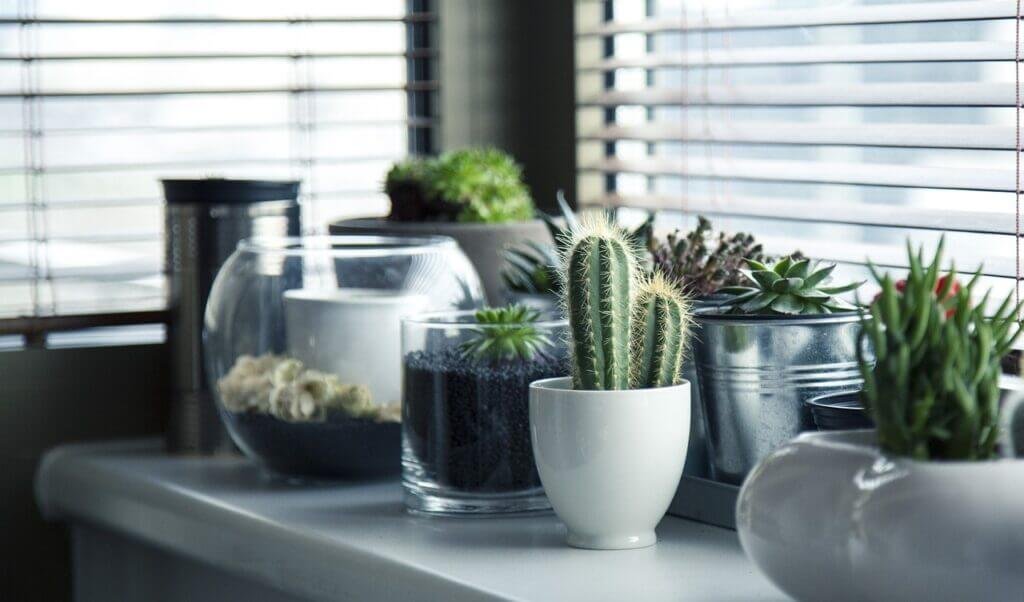Living in a bustling city can be both exciting and overwhelming, but amidst all the hustle and bustle, have you ever wondered how to shield your precious plants from the harmful effects of air pollution? Whether you’re a seasoned gardener or just starting your green-thumb journey, it’s important to understand the threats that urban air pollution poses to our leafy friends. In this article, we’ll explore some practical tips and expert advice to help you safeguard your plants and create a healthier environment for them to thrive in. So, let’s embark on this journey together and learn how to protect our plants from the grip of city air pollution.

Understanding the Impact of Air Pollution on Plants
Air pollution has a significant impact on the health and well-being of plants. The pollutants present in the air, such as nitrogen dioxide, sulfur dioxide, and particulate matter, can have various negative effects on plant growth, development, and overall health. It is essential to understand these effects in order to protect plants in urban environments effectively.
Effects of Air Pollution on Plants
Air pollution can have detrimental effects on plants in several ways. One of the primary concerns is the damage caused to the leaves. Pollutants can lead to leaf discoloration, necrosis (tissue death), and even premature leaf drop. This decreases the plant’s ability to photosynthesize effectively, reducing its growth and vigor.
Furthermore, air pollution can hinder the plant’s ability to take in carbon dioxide, which is vital for photosynthesis. This can impair the plant’s growth and limit its overall productivity. Additionally, pollutants can penetrate the plant’s stomata, tiny openings on the leaves’ surface responsible for gas exchange, resulting in reduced photosynthetic capacity.
Air pollution can also affect the plant’s reproductive process. Pollutants like sulfur dioxide can interfere with pollen germination and fertilization, leading to reduced seed production. Furthermore, pollutants can also impact the quality of seeds, resulting in weakened offspring with reduced abilities to withstand environmental stress.

Sources of Air Pollution in the City
Cities are often major contributors to air pollution due to industrial activities, vehicular emissions, and other human activities. The combustion of fossil fuels, such as coal and petrol, releases significant amounts of pollutants into the air. Industrial processes, including manufacturing and power generation, release pollutants like sulfur dioxide and nitrogen dioxide. Even household activities like cooking and heating can contribute to air pollution.
Traffic is a significant source of air pollution in urban areas. Vehicle exhaust emits pollutants like carbon monoxide, nitrogen oxides, and particulate matter. These pollutants can accumulate in the air and be transported to nearby plants, causing damage to their leaves and overall health.
Selecting Suitable Plants
To mitigate the adverse effects of air pollution on plants, it is crucial to choose plants that have a high tolerance to pollutants found in urban environments.
Choosing Plants with High Tolerance to Air Pollution
Certain plant species have evolved to withstand the harsh conditions of urban areas and exhibit a higher tolerance to air pollution. These plants are generally referred to as “pollution-tolerant” or “urban-tolerant” species. They have adapted mechanisms to minimize the damage caused by pollutants and are better equipped to survive in polluted environments.
When selecting plants for your garden or urban green spaces, consider species such as evergreen trees, shrubs with waxy leaves, and ornamental grasses known for their pollution tolerance. These plants will have a higher chance of thriving despite the presence of pollutants in the air.
Consider Native and Indigenous Species
Native and indigenous plants are well-suited to their local environment, including the air quality conditions. They have developed natural defenses against air pollution and are an excellent choice for planting in urban areas. Native plants also offer additional benefits, such as providing habitat for local wildlife and promoting biodiversity.
When choosing plants, consult with local horticulturists or nurseries to identify suitable native species that can thrive in your specific region. By incorporating native plants into your garden or urban green spaces, you create a more resilient ecosystem that is better adapted to local air pollution conditions.
Opting for Small-Sized Plants
In urban areas, space is often limited. Opting for small-sized plants such as shrubs or compact trees can be advantageous in several ways when it comes to air pollution. First, smaller plants generally have a smaller leaf surface area, which means they have a reduced exposure to pollutants. Second, they are less likely to block airflow and can potentially help disperse pollutants more effectively. Finally, smaller plants are easier to maintain and manage, especially for those with limited gardening experience or time.
When selecting small-sized plants, consider options like dwarf varieties or compact cultivars of your preferred species. These plants can still provide beauty and greenery to your surroundings while minimizing their susceptibility to air pollution.

Creating a Healthy Microclimate
In addition to selecting suitable plants, creating a healthy microclimate can help protect plants from the harmful effects of air pollution. Implementing various techniques can help create a more favorable environment for plant growth and maximize their ability to cope with pollution.
Implementing Vertical Gardening Techniques
Vertical gardening techniques, such as growing plants on walls or trellises, can help mitigate the effects of air pollution. By elevating plants above ground level, you reduce their exposure to pollutants present closer to the surface. Additionally, vertical gardening can help optimize sunlight exposure, allow better air circulation, and enhance overall aesthetic appeal.
Consider installing climbing plants like ivy or vine plants on walls or using vertical planters on balconies or fences. These techniques not only provide space-saving solutions but also contribute to cleaner air for your plants.
Planting in Raised Beds or Containers
Planting in raised beds or containers can offer several benefits when dealing with air pollution. Raised beds provide a barrier between the plant’s roots and the contaminated soil below, reducing the risk of pollutants being absorbed through the roots. Containers provide even more control, allowing you to choose and monitor the quality of the soil used.
When using raised beds or containers, ensure proper drainage to prevent waterlogging and select suitable potting mixes that promote healthy plant growth. This method is particularly useful when dealing with limited space or areas with heavily contaminated soil.
Creating Windbreaks and Barriers
Air pollution is often accompanied by high winds, which can exacerbate its effects on plants. Creating windbreaks or barriers, such as hedges or fences, can help protect your plants by reducing the wind speed and directing pollutants away from them.
Consider planting dense shrubs or installing permeable fences around your garden or urban green spaces. These barriers will act as filters, slowing down the wind and capturing airborne pollutants. Additionally, they provide aesthetic value and contribute to a more peaceful and private outdoor environment.
Providing Adequate Water and Nutrients
Air pollution can affect plants’ ability to absorb water and nutrients from the soil, making it essential to maintain optimal moisture levels and provide adequate nutrients. Regularly water your plants, ensuring the soil stays evenly moist but not waterlogged. Mulching the soil can also help retain moisture and regulate soil temperature.
In polluted areas, the deposition of pollutants on the plant’s leaves can interfere with nutrient uptake. Consider supplementing your plants with organic fertilizers or foliar sprays to ensure they receive the necessary nutrients. Regular soil testing and monitoring can also help identify any deficiencies and allow for timely correction.
Reducing Outdoor Air Pollution
While protecting plants within your own space is crucial, taking steps to reduce outdoor air pollution can create a more sustainable and healthier environment for all living beings. By advocating for cleaner air and adopting sustainable practices, you contribute to the overall well-being of plants and other living organisms.
Supporting Policies for Cleaner Air
Stay informed about air pollution and support policies aimed at reducing emissions and improving air quality in your city. Get involved in local advocacy groups or join campaigns that promote cleaner air. Your voice can make a difference and lead to better regulations and policies to protect plants and the environment.
Promoting Green Infrastructure
Green infrastructure refers to the integration of natural elements, such as trees, parks, and green roofs, into urban spaces. These elements can help mitigate and absorb air pollutants, thereby improving overall air quality. Promote the importance of green infrastructure in your community and encourage the implementation of green spaces in urban planning.
Consider participating in tree planting initiatives or advocating for the preservation and expansion of existing green areas. By increasing the presence of vegetation in cities, we can better combat air pollution and provide a safer environment for plants and people alike.
Encouraging Sustainable Transportation
Vehicle emissions are a significant source of air pollution in cities. Encourage sustainable transportation methods, such as walking, biking, or using public transportation. By reducing the number of vehicles on the road, we can effectively minimize air pollution levels and create healthier urban environments for plants and humans.
Additionally, support the use of electric vehicles and advocate for the development of charging infrastructure. Transitioning to cleaner modes of transportation is crucial in achieving long-term air pollution reduction goals.
Using Energy-Efficient Practices
Energy production and consumption contribute significantly to air pollution. Adopt energy-efficient practices in your home and encourage others to do the same. Reduce energy consumption by using energy-efficient appliances, switching to LED lighting, and properly insulating your space. By conserving energy, we can reduce the emissions from power generation, ultimately improving air quality for plants and the entire community.
Participating in Clean-Up Days
Organize or participate in community clean-up days to remove litter and debris from public spaces. Proper waste management is essential in preventing pollutants from entering the air and causing harm to plants and ecosystems. By actively engaging in clean-up efforts, you are not only helping protect plants but also fostering a sense of community and environmental responsibility.
Managing Indoor Air Quality
While outdoor air pollution is a considerable concern, we must also address indoor air quality to protect our plants effectively. Indoor environments can harbor pollutants from sources such as cleaning chemicals, volatile organic compounds (VOCs) from furniture or paints, and even inadequate ventilation.
Using Air Purifying Plants
Certain plant species have the ability to remove indoor air pollutants and improve air quality. Consider incorporating air purifying plants, such as snake plants, peace lilies, or spider plants, into your indoor spaces. These plants can absorb and neutralize harmful substances, providing you and your plants with cleaner air.
Ensure proper care and maintenance for these plants, as they might require specific growing conditions. Regularly monitor and replace them if their efficiency in purifying the air diminishes.
Keeping Indoor Plants Healthy
Indoor plants also require proper care and attention to thrive in enclosed spaces. Provide adequate sunlight, water, and nutrients to support their growth. Regularly monitor the moisture levels in the soil and adjust watering accordingly. Fertilize indoor plants according to their specific needs to maintain their health and resilience.
Inspect indoor plants regularly for signs of pests or diseases. Promptly address any issues to prevent their spread and potential harm to your plants. Maintaining a healthy indoor environment for your plants promotes their longevity and ability to withstand indoor air pollution.
Using HEPA Filters and Air Purifiers
Consider using high-efficiency particulate air (HEPA) filters or air purifiers in indoor spaces to remove airborne pollutants. HEPA filters can trap fine particles, including dust, pollen, and some pollutants, improving the overall air quality. Air purifiers equipped with activated carbon filters can also help absorb harmful gases and odors from the air.
Place these filters or purifiers strategically in areas with a higher concentration of indoor pollutants, such as near sources of potential contamination or in rooms with poor ventilation. Remember to regularly maintain and replace filters according to the manufacturer’s instructions for optimal performance.
Regular Cleaning and Dusting
Regular cleaning and dusting of indoor spaces are vital to reduce the accumulation of pollutants and improve indoor air quality. Dust and wipe down surfaces, including plant leaves, to remove dust particles and potential pollutants. Vacuum carpets and rugs regularly to minimize the accumulation of fine particles.
Avoid using harsh chemicals during cleaning, as they can introduce additional pollutants into the air. Opt for natural cleaning solutions or environmentally friendly products to maintain a healthier indoor environment for both you and your plants.
Implementing Protective Measures
Protecting plants from air pollution may require implementing additional physical measures to reduce their exposure to pollutants. The following protective measures can help safeguard your plants and minimize the damage caused by air pollution.
Covering Plants During High Pollution Days
During periods of high air pollution, it may be beneficial to cover your plants temporarily. Protective covers, such as fine mesh or breathable fabric, can shield plants from direct contact with pollutants. This can help prevent leaf damage and reduce the plant’s overall exposure to harmful substances.
Ensure proper ventilation when covering plants to avoid trapping excessive heat or moisture. Monitor air pollution levels to determine when it is necessary to cover your plants and remove the covers once pollution levels decrease.
Applying Protective Coatings and Sprays
Applying protective coatings or sprays on plant surfaces can create a physical barrier, reducing the impact of air pollutants. These coatings can be organic or chemical-based and are designed to prevent pollutants from directly contacting the plant’s leaves.
Before applying any protective products, carefully read and follow the instructions provided by the manufacturer. Consider consulting with horticulturists or plant care professionals to ensure the appropriate use of these coatings or sprays for your specific plant species.
Using Physical Barriers
Physical barriers, such as screens or fences, can help create a buffer zone that prevents pollutants from reaching your plants directly. When designing your outdoor space, consider incorporating these barriers to shield your plants from pollution sources, such as busy roads or industrial facilities.
Choose materials that are sturdy, durable, and visually appealing. Ensure the barriers are properly installed and allow for adequate air circulation to prevent the build-up of pollutants in the immediate vicinity of the plants.
Implementing Awnings and Canopies
Awnings and canopies offer both shade and protection to plants, shielding them from direct sunlight exposure and airborne pollutants. These structures serve as an overhead cover, reducing the direct impact of pollutants on your plants.
Consider installing awnings or canopies above plants in outdoor areas or positioning them strategically to create shaded microclimates. This not only protects your plants but also provides a more comfortable outdoor space for you to enjoy.
Placing Plants Strategically
Proper placement of plants can minimize their exposure to air pollution and maximize their ability to thrive. When designing your garden or green spaces, consider the positions of known pollution sources, such as roads or industrial sites, and place more sensitive or susceptible plants further away from these areas.
Take advantage of natural wind patterns and airflow in your location. Position taller and more pollution-tolerant plants as a barrier to divert and disperse pollutants away from your more delicate plants. By strategically placing your plants, you create a more favorable environment that promotes their growth and helps protect them from pollution.
Monitoring Air Pollution Levels
Regular monitoring of air pollution levels is essential to understanding the potential risks and taking appropriate precautionary measures for your plants. Stay informed about the air quality in your area by utilizing air pollution monitoring apps or websites that provide real-time or periodic data.
Using Air Pollution Monitoring Apps
Numerous mobile apps provide up-to-date air quality information, allowing you to monitor the pollution levels in your area. These apps use data from local monitoring stations, providing an accurate assessment of the air quality and pollutant concentrations.
Download a reputable air pollution monitoring app on your smartphone and configure it to receive relevant alerts or notifications. By staying informed, you can make informed decisions regarding the protection of your plants based on the air quality conditions in your vicinity.
Understanding Air Quality Index (AQI)
The Air Quality Index (AQI) is a standardized system used worldwide to measure and communicate the quality of the air we breathe. It provides a numerical rating that indicates the level of air pollution and associated health risks.
Familiarize yourself with the AQI scale and the associated pollutant concentrations for each category, ranging from “Good” to “Hazardous.” By understanding the AQI, you can easily interpret the air quality data provided by monitoring apps or websites and take precautionary measures accordingly.
Taking Precautionary Measures Based on AQI
Once you have determined the air quality in your area using the AQI, you can take appropriate precautionary measures to protect your plants. For example, on days with poor air quality or high pollution levels (e.g., during smog or haze events), you can implement protective measures such as covering your plants or reducing their exposure to polluted air.
Keep in mind that different plants have varying sensitivities to air pollution. Some may require more protection, while others may be more tolerant. Understanding the AQI and its implications allows you to tailor your protective measures to suit the specific needs of your plants.
Regular Plant Care and Maintenance
Ensuring the proper care and maintenance of your plants is vital to help them withstand the impacts of air pollution. By adopting good gardening practices, you can create a healthier and more resilient environment for your plants.
Watering and Fertilizing Properly
Optimal watering and fertilizing practices are crucial for plant health, especially in polluted environments. Provide your plants with an appropriate amount of water, taking into account factors such as soil moisture levels, weather conditions, and individual plant requirements. Avoid overwatering, as this can lead to root rot and increase the risk of fungal diseases.
Similarly, fertilize your plants using balanced and appropriate fertilizers. Avoid excessive fertilization, as it can contribute to nutrient imbalances and increased susceptibility to pests and diseases. Regularly monitor your plants’ nutrient levels and adjust your fertilization practices accordingly.
Pruning and Removing Damaged Leaves
Regular pruning and removing damaged leaves are essential for plant health and vitality. By removing diseased or damaged foliage, you can prevent the spread of diseases and increase overall plant vigor.
Inspect your plants regularly for signs of damage, including yellowing leaves, necrosis, or lesions. Use sharp and clean pruning tools to remove affected portions, ensuring proper disposal to avoid contamination. Pruning also helps improve air circulation, reducing the risk of fungal infections and promoting healthier growth.
Managing Pests and Diseases
Air pollution can weaken plants and make them more susceptible to pests and diseases. Implement proactive measures to manage pests and diseases effectively. Regularly monitor your plants for signs of infestation or infection, such as discolored leaves, wilting, or distorted growth.
Consider using integrated pest management (IPM) techniques, which focus on prevention, monitoring, and environmentally friendly approaches to pest and disease control. This may include manual removal of pests, introducing beneficial insects, or utilizing organic pest control methods.
Mulching and Weed Control
Mulching and proper weed control are essential for maintaining healthy plants in polluted environments. Apply a layer of organic mulch around your plants to conserve moisture, regulate soil temperature, and suppress weed growth. Mulch also acts as a physical barrier, reducing the direct impact of pollutants on the soil and roots.
Regularly inspect and remove weeds in your garden or urban green spaces. Weeds compete with your plants for nutrients and water, increasing stress and hindering their growth. By keeping unwanted weeds in check, you provide your plants with a better chance of thriving despite the presence of air pollution.
Educating and Creating Awareness
Educating yourself and others about the impact of air pollution on plants is crucial in promoting a greener and healthier environment. By creating awareness, you can inspire others to take action and contribute to the well-being of plants and the overall ecosystem.
Promoting Environmental Education
Promote environmental education programs in schools, community centers, or local organizations. Advocate for curricula or workshops that focus on the importance of air quality, plant health, and sustainable practices. By incorporating these topics into educational programs, we can instill a sense of responsibility and foster environmentally conscious individuals from a young age.
Organizing Workshops and Seminars
Organize workshops or seminars to share knowledge and practical tips on protecting plants from air pollution. Invite experts in the field of horticulture, environmental science, or pollution control to lead these events. Cover topics such as suitable plant selection, microclimate creation, and practical measures for reducing pollution. Engaging the community in such events encourages collective learning and empowers individuals to make a positive impact in their own green spaces.
Engaging in Community Planting Projects
Participate in community planting projects or initiate your own to promote greener urban environments. Collaborate with local authorities, community groups, or environmental organizations to organize tree planting campaigns or beautification projects. Not only do these initiatives contribute to cleaner air and improved plant health, but they also provide opportunities for community building and fostering a sense of pride in shared landscapes.
Sharing Information on Social Media
Utilize social media platforms to share information and raise awareness about the impact of air pollution on plants. Regularly post tips, facts, and success stories related to protecting plants in polluted environments. Encourage your followers to take action, share their experiences, and spread the message to their own networks. By harnessing the power of social media, we can reach a broader audience and inspire positive change.
Seeking Professional Assistance
Sometimes, the expertise and guidance of professionals in the field of horticulture, botany, or environmental science are invaluable in protecting plants from air pollution. If you encounter challenges or require specific advice, consider reaching out to these experts for assistance.
Consulting with Horticulturists or Botanists
Horticulturists and botanists possess in-depth knowledge about plants’ needs and vulnerabilities in different environmental conditions. Consult with these professionals to identify suitable plant species for your specific location, implement effective protective measures, and receive personalized advice for your plants’ care and maintenance. Their expertise can help ensure the long-term health and resilience of your plants in the face of air pollution.
Engaging Plant Care Services
If you have limited time or experience in plant care, consider engaging professional plant care services. These experts can provide regular maintenance, monitor plant health, and implement protective measures on your behalf. Hiring these services can alleviate the burden of plant care and ensure your plants receive the attention they need to thrive despite air pollution.
Reaching Out to Environmental Agencies
Local environmental agencies may offer additional resources and support for protecting plants from air pollution. Reach out to these agencies to inquire about specific programs, initiatives, or services available in your area. They may be able to provide guidance, funding opportunities, or access to specialized equipment for monitoring air quality or implementing protective measures.
In conclusion, protecting plants from air pollution in urban areas requires a multi-faceted approach. By understanding the impact of air pollution, selecting suitable plants, creating a healthy microclimate, reducing outdoor air pollution, managing indoor air quality, implementing protective measures, monitoring pollution levels, and providing regular care and maintenance, you can help safeguard the health and well-being of your plants. Moreover, educating and creating awareness, as well as seeking professional assistance when needed, contribute to a more sustainable and greener urban environment. Together, we can ensure a healthier future for both plants and humans in the face of air pollution in the city.


